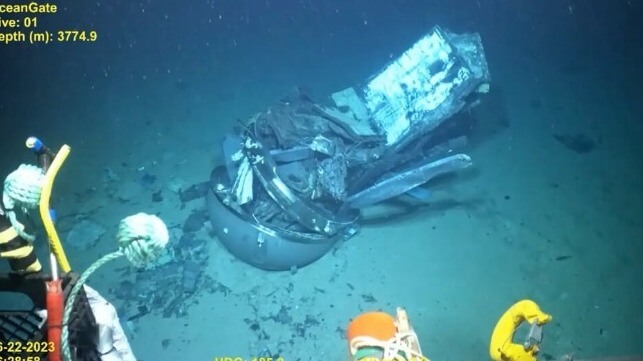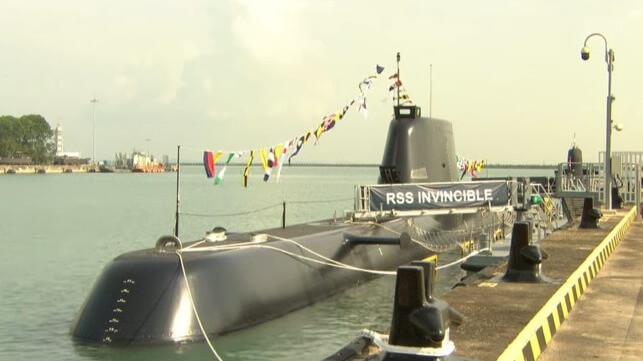SUBMARINERS
U.S. Coast Guard Releases Audio of Lost Submersible's Implosion

For the first time, the U.S. Coast Guard has released audio from the implosion of the submersible Titan, which was lost during a dive at the Titanic wreck site in the North Atlantic in 2023. Four paying "mission specialists" and the operating company's CEO died in the implosion, making it the first fatal accident in five decades in a deep-diving manned submersible.
The Coast Guard believes that the craft's experimental carbon hull imploded rapidly, with little or no warning. A NOAA acoustic buoy captured the sound of the underwater blast from miles away - one of the first hints that the dive had ended in tragedy.
According to evidence uncovered by an ongoing Marine Board of Investigation inquiry, the Titan accumulated a long list of safety issues in the years leading up to the casualty. The sub (and an earlier prototype hull) partially sank at the pier, ran out of battery power while submerged, lost its forward dome during a recovery, and failed to drop weights on multiple occasions.
Former Oceangate employees testified that co-founder and CEO Richard Stockton Rush III chose not to pursue classification or a Coast Guard Certificate of Inspection (COI) for the novel design, despite repeated warnings from third-party engineering consultants and his own staff. Rush was aware of the experimental nature of Oceangate's commercially-operated vessel: before the disaster that claimed his life, he told a conference audience that "when you're outside the box, it's hard to tell how really far outside the box you are," adding that Oceangate was "pretty far out there."
"These [conventional] research subs that are out there, they were never meant to make money. They were meant to get out there and do cool stuff," Rush told the audience. "[Sub certification programs] are over the top in their rules and regulations."
Singapore's "Invincible" New Submarine Force

Singapore’s introduction into operational service of its new Invincible class of submarines appears to be an extraordinary success, offering valuable lessons for its former colonial master - the United Kingdom, which is now grappling with crew retention issues and its own challenging submarine expansion program under the aegis of AUKUS.
The first two Type 218SG submarines of the Invincible-class, RSS Invincible and RSS Impeccable, were commissioned into operational service on September 24, 2024 at Changi Naval Base. In his commissioning speech, Prime Minister Lawrence Wong described the program as critical to Singapore’s survival and prosperity as a maritime nation, and one which also lacks strategic depth.
The boats were built by ThyssenKrupp Marine Systems in Germany, but were heavily customized to meet Singapore’s particular needs. The submarines are designed ergonomically to suit Singaporean national servicemen, both from a physical and tech-savvy perspective. The well-planned working environment will help attract and retain high-caliber crews, both male and female, drawn from a nation committed to its national service program. Sensors, navigation and weapons systems are optimized for operations in congested and shallow waters, as found in the Malacca Straits and the South China Sea.
Diesel-powered, the Invincible submarines can travel at 10 knots surfaced, 15 knots underwater. With an air independent propulsion system for battery charging, the submarines can remain submerged for an estimated 45 days without snorkeling. Cruise endurance is unknown. With a total of ten 21- and 26-inch torpedo tubes, the submarines should be able to launch heavy torpedoes, anti-ship missiles and mines, and to deliver special force teams underwater through an airlock.
The submarines have been brought into service relatively quickly because the Singaporean Navy’s 7th Flotilla has built up a cadre of experienced crews through its previous operation of smaller Swedish Archer-class submarines, which will now begin to be retired from service.
In service, Singapore will face significant operational challenges. As a small island state, deployed submarines underwater will provide a valuable hinterland; but conversely, the boats will be particularly vulnerable while in port, even if a protection-from-view shed has been built wharfside to hide their presence or absence.
Two further submarines in the class, RSS Illustrious and RSS Inimitable, are due in service by the end of 2025. The overall cost of the program has been estimated as $1.8 billion. A fifth boat may also have been ordered. Other nearby nations may well be tempted to replicate Singapore’s submarine development programme, but Singapore has a 25-year head start.
Iran Releases Footage of "World's First" Sub-Launched Suicide Drone

Iran's defense ministry has released footage of what it claims to be the world's first submarine-launched loitering munition (suicide drone). A brief video run by state news shows a delivery device emerging from below the water, then blowing off its nosecone and ejecting a folding-wing drone into the air.
The ministry said that - unlike most drones - this munition is autonomous. Once launched, it operates without a man in the loop or human remote control, and finds and destroys its target using AI. This eliminates the need for a radio link to a control station, reducing vulnerability to electronic countermeasures.
For Western operators, AI-controlled lethal munitions are a matter of ethical concern, but the U.S. and many other nations are moving ahead rapidly in developing the technology - led by Ukraine and Russia. Both militaries have thousands of hours of combat video feed from drone operators on the front line in Ukraine, and that footage is key for training AI models how to identify real military targets.
Iran has an active and well-developed drone program, and has previously used long-range loitering munitions to attack shipping. It has even converted a small boxship into a "drone carrier" specifically for this purpose. its proxy force in Yemen - the Houthi rebel group - has used hundreds of shore-launched drones to attack Western merchant vessels and warships in the Red Sea. If practical in real-world use, Iran's new submarine-launched drone could begin its flight from a position closer to the target vessel, reducing the time available to detect and defeat it.
Iran's ministry of defense claims that the new AI-driven drone can be launched from an autonomous underwater vehicle (AUV), increasing stealth and lowering risk to Iranian personnel. The underwater delivery device portrayed in Wednesday's video bears visual similarity to Iran's small torpedo-shaped AUV, evidence of which has been captured by U.S. forces in the Houthi conflict.
No comments:
Post a Comment